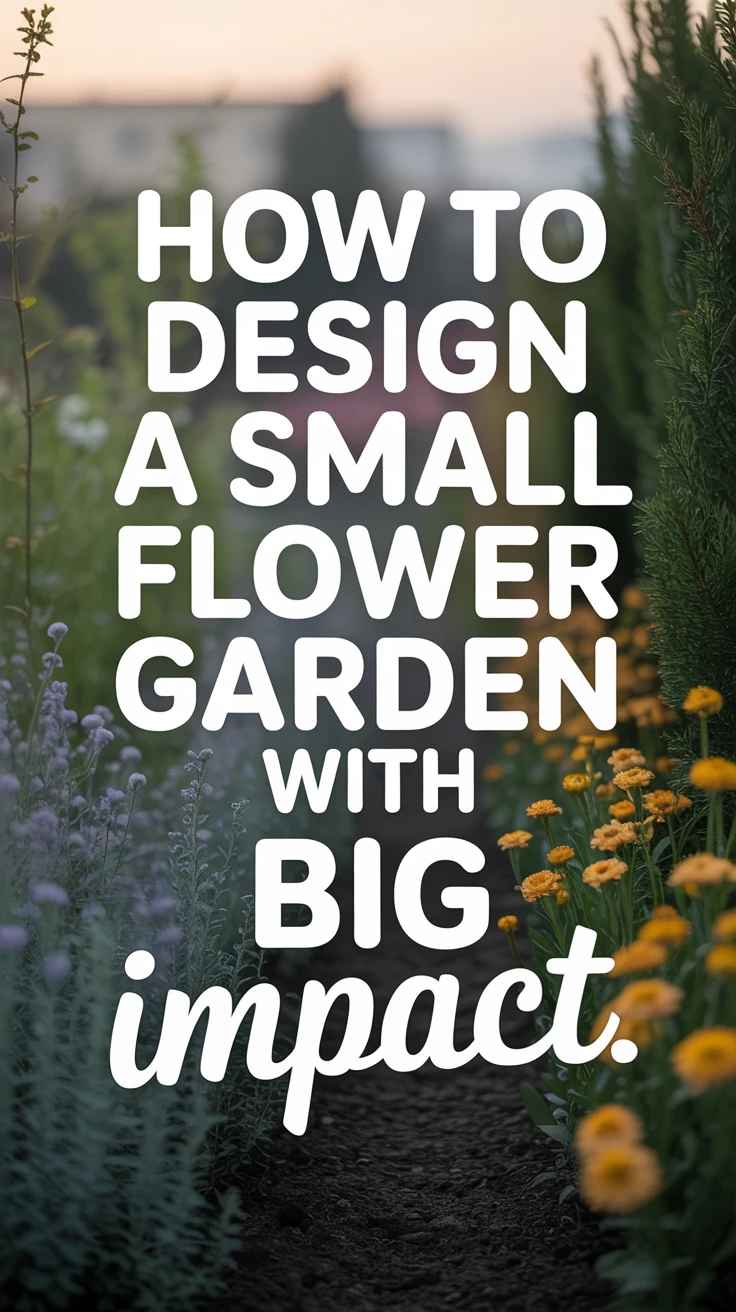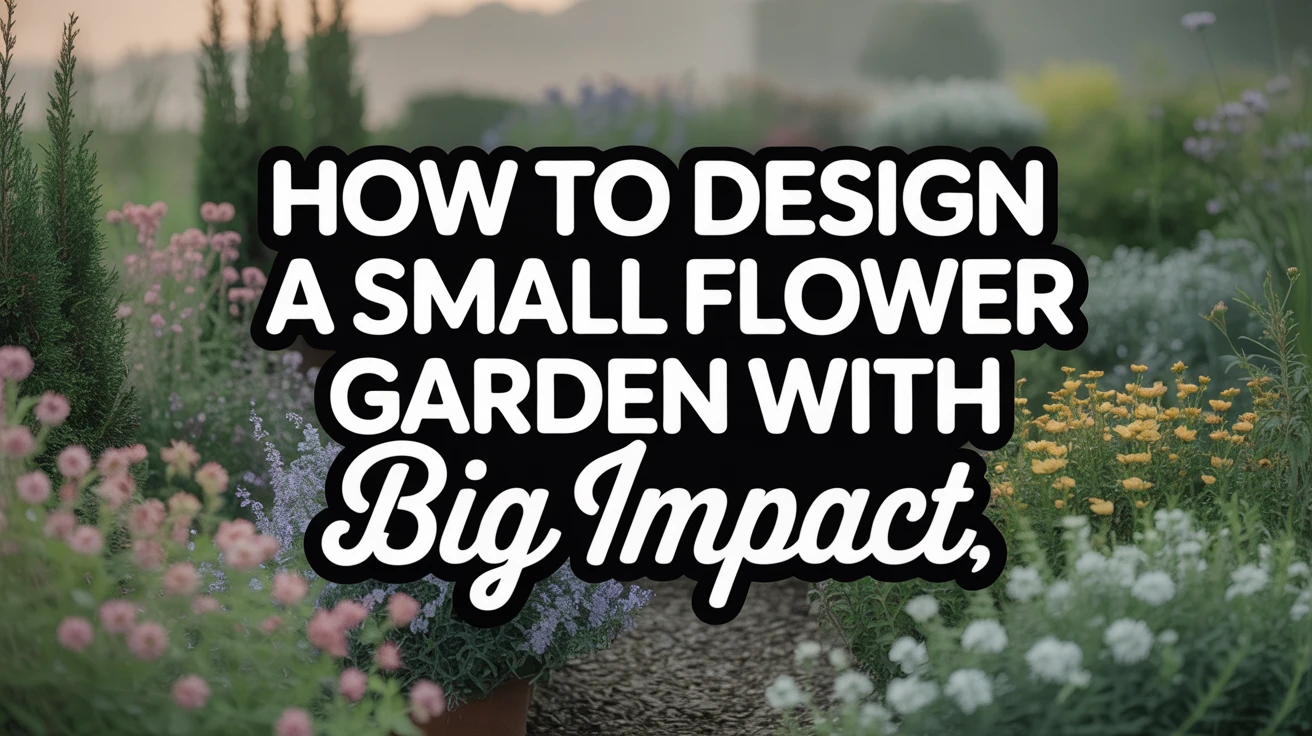
Introduction
There’s something magical about a flower garden, no matter its size. As a garden designer who’s worked with spaces of all dimensions, I’ve found that small flower gardens often deliver the most satisfying results. They’re manageable, affordable, and can pack an incredible visual punch when designed thoughtfully. Whether you’re working with a tiny urban yard, a balcony, or just a corner of your property, I’m excited to share how you can transform that modest space into a breathtaking floral display that rivals gardens many times its size. Throughout my career, I’ve learned that constraints often spark creativity—and a small garden space is the perfect canvas to prove this point. Let’s explore how to make your small flower garden dreams bloom into reality.
Choosing the Right Spot

Finding the perfect location for your small flower garden is crucial for success. I learned this lesson the hard way when I placed my first garden bed in a shady corner that I thought would “get enough sun.” Spoiler alert: it didn’t, and I watched my sun-loving plants struggle all season.
When selecting your garden spot, consider these essential factors:
- Sunlight assessment: Most flowering plants need at least 6 hours of direct sunlight daily. I recommend tracking sun patterns for a few days before deciding.
- Soil quality: Test your soil’s pH and composition. I’ve saved countless gardens by addressing soil issues before planting.
- Water access: Ensure you can easily reach the area with a hose or watering can.
- Visibility: Place your garden where you’ll see and enjoy it frequently.
- Wind exposure: Protect delicate flowers from strong winds that can damage stems and blooms.
Pro Tip: When evaluating potential spots, I always bring a chair and sit in the location at different times of day. This simple practice helps me understand how the light changes and gives me a sense of how the garden will be experienced.
Selecting Suitable Plants

Plant selection can make or break a small garden. In my early days of designing compact spaces, I made the classic mistake of choosing plants that quickly outgrew their boundaries. Now I know better—and so will you!
The best plants for small flower gardens share certain characteristics:
- Compact growth habits: Look for varieties labeled as dwarf, miniature, or compact.
- Multi-season interest: Choose plants that offer more than just flowers—interesting foliage, seed heads, or fall color extends your garden’s appeal.
- Vertical growth: Plants that grow upward rather than outward save precious ground space.
- Long blooming periods: Get more bang for your buck with varieties that flower for weeks or months.
Some of my favorite plants for small spaces include:
- Dwarf Coneflowers: Compact versions of these native favorites attract pollinators and bloom for months.
- Coral Bells (Heuchera): Stunning foliage in various colors provides year-round interest.
- Dwarf Hydrangeas: Varieties like ‘Bobo’ or ‘Little Lime’ offer impressive blooms on smaller frames.
- Ornamental Grasses: Slender varieties like Japanese Forest Grass add texture without overwhelming.
- Compact Roses: Varieties like ‘Petite Knock Out’ deliver big color in small packages.
Pro Tip: I always incorporate at least 20% evergreen plants in my small garden designs. They maintain structure during winter months when deciduous plants go dormant, ensuring your garden never looks completely bare.
Design Techniques for Small Spaces
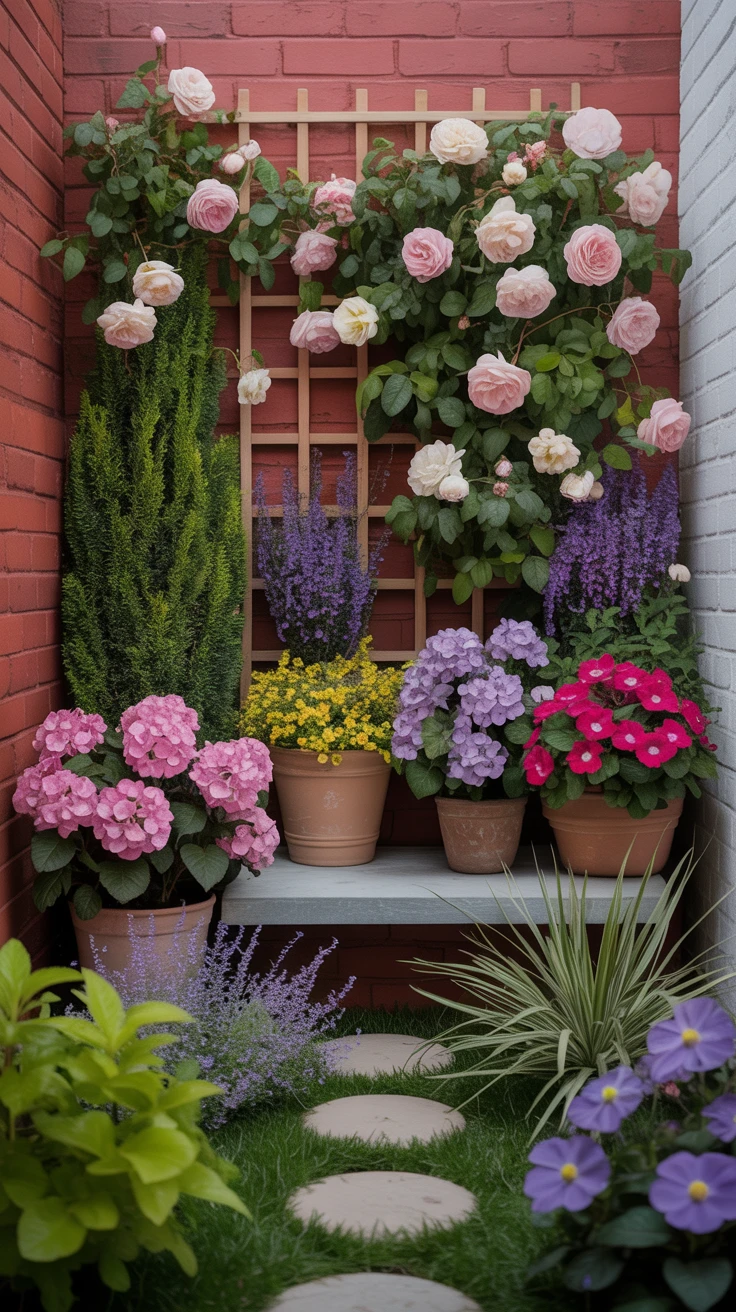
Creating impact in a small space requires strategic design. I’ve refined these approaches over years of working with challenging spaces, often learning through trial and error.
- Embrace vertical gardening: I once transformed a tiny 4×6 foot plot by installing a simple trellis and training climbing roses and clematis upward. The result? Triple the flowering space without expanding the footprint.
- Use containers strategically: Pots and planters add height, can be moved seasonally, and allow you to grow plants that might not thrive in your native soil.
- Create layers: Plant in tiers with taller plants at the back, medium in the middle, and low-growing at the front for maximum visual impact.
- Limit your color palette: I’ve found that restricting colors to 2-3 complementary hues creates a more cohesive, impactful look than a rainbow approach.
- Incorporate hardscaping: Small ornaments, stepping stones, or a diminutive bench create focal points and add dimension.
Pro Tip: One of my most successful small garden designs used the “thriller, filler, spiller” approach in both containers and in-ground plantings. Place a striking vertical element (thriller) at the center or back, surround it with mounding plants (fillers), and edge with cascading varieties (spillers) for a garden that feels abundant without being crowded.
Maintenance Tips for Small Flower Gardens
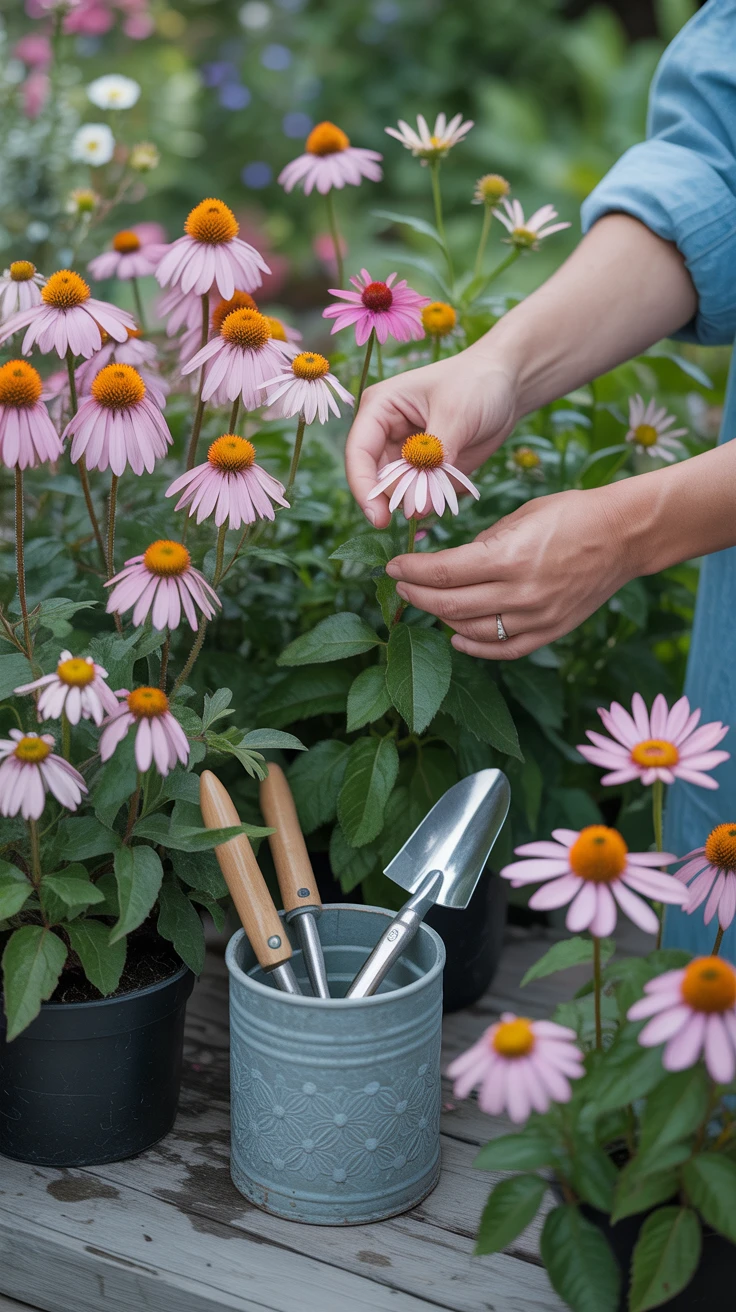
The good news about small gardens? They’re easier to maintain! However, they do require consistent attention since every plant plays a crucial role in the overall design. I’ve developed these maintenance routines through years of professional and personal gardening:
- Regular deadheading: Remove spent blooms promptly to encourage more flowers and maintain a tidy appearance.
- Strategic pruning: In small spaces, proper pruning prevents plants from overwhelming neighbors. I trim perennials and shrubs at least twice a season.
- Consistent watering: Small gardens often dry out faster than larger ones. I use drip irrigation whenever possible to deliver water efficiently.
- Seasonal refreshes: I replace fading seasonal plants with fresh options to maintain continuous interest.
- Vigilant weeding: In compact gardens, weeds are not just unsightly—they compete aggressively for limited resources.
Pro Tip: I keep a small garden toolkit (pruners, trowel, gloves, and collection bag) in a decorative container near my small garden. This makes it easy to perform quick maintenance whenever I notice something needs attention, rather than putting it off until it becomes a bigger job.
Pro Tips for a Stunning Small Flower Garden
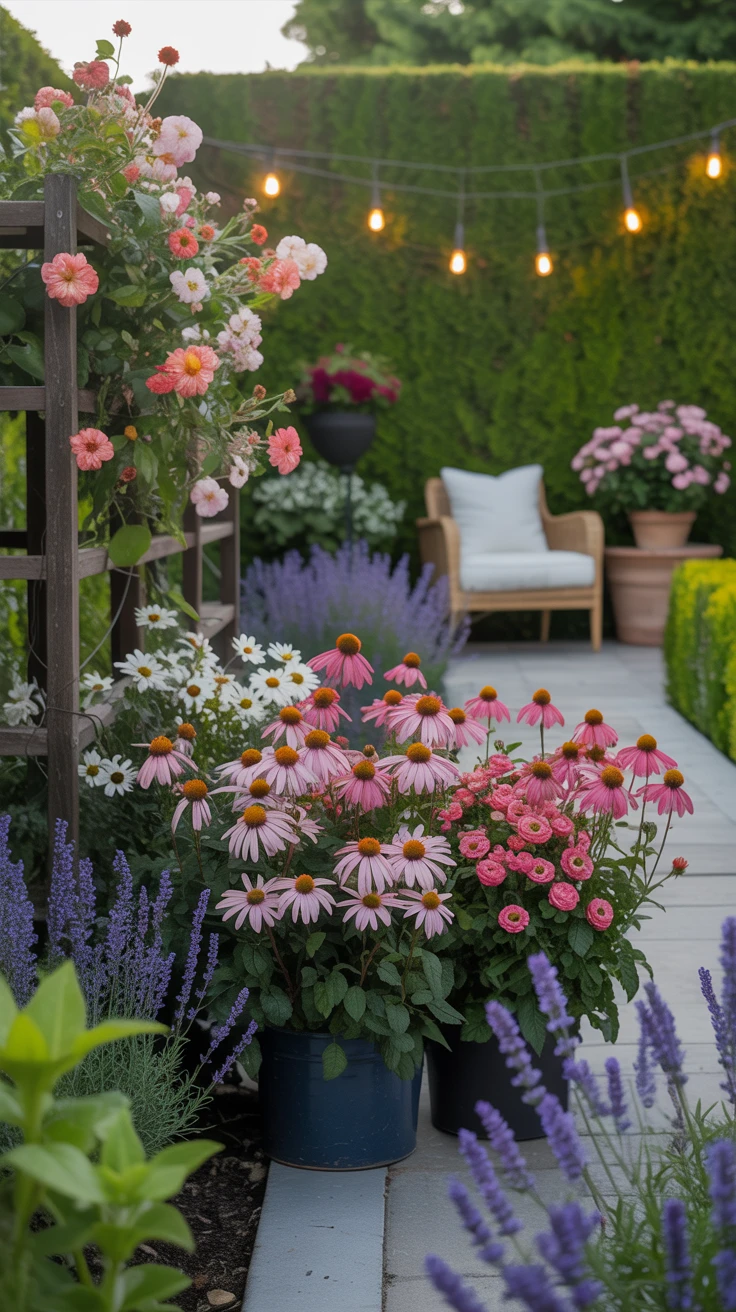
After designing dozens of small gardens, I’ve collected some insider knowledge that can elevate your space from pleasant to extraordinary:
- Create garden rooms: Even in tiny spaces, using low hedges or ornamental grasses to divide areas creates the illusion of a larger garden with distinct “rooms” to discover.
- Incorporate fragrance: Scented plants have outsized impact in small spaces. I place aromatic varieties like lavender or heliotrope near seating areas or walkways.
- Add night interest: Include white or pale-colored flowers that glow in twilight, or install subtle lighting to extend garden enjoyment into evening hours.
- Practice succession planting: As one plant finishes blooming, another should be starting. I map out bloom times carefully to ensure continuous color.
- Include edibles: Many herbs and compact vegetable varieties offer beautiful flowers alongside their culinary benefits.
Pro Tip: I photograph my small gardens monthly throughout the growing season. This visual record helps me identify gaps in bloom time or areas that need improvement for the following year—a practice that has dramatically improved my designs over time.
Conclusion
Creating a small flower garden with big impact isn’t about cramming as many plants as possible into a limited space. Rather, it’s about thoughtful design, strategic plant selection, and consistent care. I’ve seen firsthand how even the tiniest garden can become a sanctuary that delivers joy far beyond its physical dimensions.
Remember that gardening is a journey, not a destination. My own small gardens have evolved significantly over the years as I’ve learned what works and what doesn’t. Don’t be afraid to experiment, adjust, and sometimes start over. The beauty of a small garden is that changes can be implemented quickly and affordably.
Whether you’re designing for a postage-stamp urban yard, a balcony, or just a corner of your property, these principles will help you create a flower garden that feels abundant, cohesive, and deeply personal. Happy gardening!
Frequently Asked Questions
What are the best flowers for small gardens that bloom all season?
In my experience, the most reliable long-bloomers for small spaces include calibrachoa, everblooming compact roses, reblooming dwarf daylilies, and perennial geraniums. I’ve had particular success with ‘Diamond Frost’ euphorbia, which flowers continuously from spring through fall and mixes beautifully with other plants.
How do I maintain a small garden with limited time?
Focus on low-maintenance plants suited to your conditions, install drip irrigation on a timer, apply a quality mulch to suppress weeds, and dedicate just 10-15 minutes twice weekly for deadheading and quick maintenance. I’ve found that these short, regular sessions prevent problems from becoming overwhelming.
Can I grow a flower garden on a balcony or patio?
Absolutely! I’ve designed stunning container gardens for balconies as small as 4×6 feet. Use lightweight containers, ensure proper drainage, select appropriate plants for your light conditions, and consider vertical options like wall planters or railing boxes to maximize your space.
How do I create year-round interest in a small flower garden?
Include structural elements like small evergreens or ornamental grasses, select plants with interesting seed heads or winter form, incorporate plants with colorful stems or bark, and add hardscape elements that look attractive in all seasons. My small gardens always include at least 30% plants chosen specifically for winter interest.
What’s the biggest mistake people make with small flower gardens?
Without question, it’s overcrowding. I made this mistake repeatedly in my early designs, planting everything too closely in an attempt to create instant impact. This leads to competition, poor air circulation, and eventually, plant failure. Respect mature plant sizes and be patient—a properly spaced garden will fill in beautifully and require far less maintenance.
